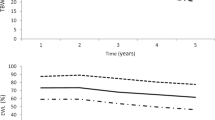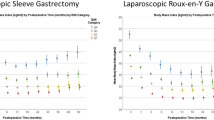Abstract
Background/Objective
A successful Long-Term Weight Loss (LTWL) is associated with a more favorable metabolic disease risk profile. However, evidence is limited on the association of LTWL with obesity-related complications defined by Edmonton obesity staging system (EOSS). Hence, our study aims to assess the association between LTWL thresholds and obesity-related complications defined by EOSS among the adult US population.
Subjects/Methods
We used data from the National Health and Nutrition Examination Survey (NHANES) from 2011 to 2018. Adults 18 years or older with overweight/obesity and long-term weight loss were included in the analysis. The association between long-term weight loss and obesity-related complications defined by EOSS was investigated. A multivariable logistic regression model was employed by adjusting for potential covariates.
Results
A total of 22,223 adults were included in the analysis. Overall, 61.8% of participants had long-term weight loss of <5%, and 4.8% of participants had successful long-term weight loss of 20% or greater. The highest long-term weight loss threshold ( ≥ 20%) had the lowest odds of EOSS stage ≥ 2 (odds ratio [OR] = 0.60; 95% CI:0.50, 0.72; p < 0.001). The lowest LTWL threshold (5–9.9%) was relatively associated with lower odds for EOSS stage ≥ 2 [OR = 0.69 95% CI: 0.61, 0.78, p < 0.001].
Conclusions
The LTWL categories were significantly associated with lower odds of EOSS stage ≥ 2 compared to EOSS 0 or 1. Future longitudinal research assessing the association between LTWL and EOSS components is recommended.
This is a preview of subscription content, access via your institution
Access options
Subscribe to this journal
Receive 12 print issues and online access
$259.00 per year
only $21.58 per issue
Buy this article
- Purchase on SpringerLink
- Instant access to full article PDF
Prices may be subject to local taxes which are calculated during checkout
Similar content being viewed by others
Data availability
Data described in the paper, code book, and analytic code will be made available upon request pending.
References
The Lancet Diabetes E. Should we officially recognise obesity as a disease? Lancet Diabetes Endocrinol. 2017;5:483. e-pub ahead of print 2017/06/12; https://doi.org/10.1016/s2213-8587(17)30191-2.
Trends in adult body-mass index in 200 countries from 1975 to 2014: a pooled analysis of 1698 population-based measurement studies with 19·2 million participants. Lancet 2016; 387: 1377–96. e-pub ahead of print 2016/04/27; https://doi.org/10.1016/s0140-6736(16)30054-x.
Worldwide trends in body-mass index, underweight, overweight, and obesity from 1975 to 2016: a pooled analysis of 2416 population-based measurement studies in 128·9 million children, adolescents, and adults. Lancet 2017;390: 2627–42. e-pub ahead of print 2017/10/17; https://doi.org/10.1016/s0140-6736(17)32129-3.
WHO, Fact sheet, Obesity, and overweight. 2016. (Accessed on May 2023; https://www.who.int/news-room/fact-sheets/detail/obesity-and-overweight).
Dai H, Alsalhe TA, Chalghaf N, Riccò M, Bragazzi NL, Wu J. The global burden of disease attributable to high body mass index in 195 countries and territories, 1990-2017: An analysis of the Global Burden of Disease Study. PLoS Med. 2020;17:e1003198 https://doi.org/10.1371/journal.pmed.1003198.
Tremmel M, Gerdtham UG, Nilsson PM, Saha S. Economic Burden of Obesity: A Systematic Literature Review. Int J Environ Res Public Health 2017; 14. e-pub ahead of print 2017/04/20; https://doi.org/10.3390/ijerph14040435
Hales CM, Carroll MD, Fryar CD, Ogden CL. Prevalence of obesity among adults and youth: United States, 2015–2016. NCHS Data Brief. 2017:1–8.
Flegal KM, Kruszon-Moran D, Carroll MD, Fryar CD, Ogden CL. Trends in obesity among adults in the United States, 2005 to 2014. Jama. 2016;315:2284–91.
Okorodudu DO, Jumean MF, Montori VM, Romero-Corral A, Somers VK, Erwin PJ, et al. Diagnostic performance of body mass index to identify obesity as defined by body adiposity: a systematic review and meta-analysis. Int J Obes (Lond). 2010;34:791–9. https://doi.org/10.1038/ijo.2010.5.
Huxley R, Mendis S, Zheleznyakov E, Reddy S, Chan J. Body mass index, waist circumference and waist:hip ratio as predictors of cardiovascular risk–a review of the literature. Eur J Clin Nutr. 2010;64:16–22. https://doi.org/10.1038/ejcn.2009.68.
Sharma AM, Kushner RF. A proposed clinical staging system for obesity. Int J Obes (Lond). 2009;33:289–95. https://doi.org/10.1038/ijo.2009.2.
Casimiro Pérez JA, Fernández Quesada C, Del Val Groba Marco M, Arteaga González I, Cruz Benavides F, Ponce J, et al. Obesity Surgery Score (OSS) for Prioritization in the Bariatric Surgery Waiting List: a Need of Public Health Systems and a Literature Review. Obes Surg. 2018;28:1175–84. https://doi.org/10.1007/s11695-017-3107-6.
Valderhaug TG, Aasheim ET, Sandbu R, Jakobsen GS, Småstuen MC, Hertel JK, et al. The association between severity of King’s Obesity Staging Criteria scores and treatment choice in patients with morbid obesity: a retrospective cohort study. BMC Obes. 2016;3:51 https://doi.org/10.1186/s40608-016-0133-1.
Aasheim ET, Aylwin SJ, Radhakrishnan ST, Sood AS, Jovanovic A, Olbers T, et al. Assessment of obesity beyond body mass index to determine benefit of treatment. Clin Obes. 2011;1:77–84. https://doi.org/10.1111/j.1758-8111.2011.00017.x.
Aylwin S, Al-Zaman Y. Emerging concepts in the medical and surgical treatment of obesity. Front Horm Res. 2008;36:229–59. https://doi.org/10.1159/000115368.
DeMaria EJ, Portenier D, Wolfe L. Obesity surgery mortality risk score: proposal for a clinically useful score to predict mortality risk in patients undergoing gastric bypass. Surg Obes Relat Dis. 2007;3:134–40. https://doi.org/10.1016/j.soard.2007.01.005.
Powell-Wiley TM, Poirier P, Burke LE, Després JP, Gordon-Larsen P, Lavie CJ, et al. Obesity and Cardiovascular Disease: A Scientific Statement From the American Heart Association. Circulation. 2021;143:e984–e1010. https://doi.org/10.1161/cir.0000000000000973.
Guidelines (2013) for managing overweight and obesity in adults. Preface to the Expert Panel Report (comprehensive version which includes systematic evidence review, evidence statements, and recommendations). Obes (Silver Spring). 2014;22:S40. https://doi.org/10.1002/oby.20822.
Kasen S, Cohen P, Chen H, Must A. Obesity and psychopathology in women: a three decade prospective study. Int J Obes (Lond). 2008;32:558–66. https://doi.org/10.1038/sj.ijo.0803736.
Khafagy R, Dash S. Obesity and Cardiovascular Disease: The Emerging Role of Inflammation. Front Cardiovasc Med. 2021;8:768119. https://doi.org/10.3389/fcvm.2021.768119.
Atlantis E, Sahebolamri M, Cheema BS, Williams K. Usefulness of the Edmonton Obesity Staging System for stratifying the presence and severity of weight-related health problems in clinical and community settings: A rapid review of observational studies. Obes Rev. 2020;21:e13120. https://doi.org/10.1111/obr.13120.
Atlantis E, Fahey P, Williams K, Edwards S, Samaras K, Dugdale P, et al. Comparing the predictive ability of the Edmonton Obesity Staging System with the body mass index for use of health services and pharmacotherapies in Australian adults: A nationally representative cross-sectional study. Clin Obes. 2020;10:e12368. https://doi.org/10.1111/cob.12368.
Wing RR, Phelan S. Long-term weight loss maintenance. Am J Clin Nutr. 2005;82:222s–225s. https://doi.org/10.1093/ajcn/82.1.222S.
Li X, Perelman D, Leong AK, Fragiadakis G, Gardner CD, Snyder MP. Distinct factors associated with short-term and long-term weight loss induced by low-fat or low-carbohydrate diet intervention. Cell Rep Med. 2022;3:100870. https://doi.org/10.1016/j.xcrm.2022.100870.
Stubbs RJ, Duarte C, O’Driscoll R, Turicchi J, Kwasnicka D, Sniehotta FF, et al. The H2020 “NoHoW Project”: A Position Statement on Behavioural Approaches to Longer-Term Weight Management. Obes Facts. 2021;14:246–58. https://doi.org/10.1159/000513042.
Knell G, Li Q, Pettee Gabriel K, Shuval K. Long-Term Weight Loss and Metabolic Health in Adults Concerned With Maintaining or Losing Weight: Findings From NHANES. Mayo Clin Proc. 2018;93:1611–1616. https://doi.org/10.1016/j.mayocp.2018.04.018.
Douketis JD, Macie C, Thabane L, Williamson DF. Systematic review of long-term weight loss studies in obese adults: clinical significance and applicability to clinical practice. Int J Obes (Lond). 2005;29:1153–67. https://doi.org/10.1038/sj.ijo.0802982.
Garvey WT. New tools for weight-loss therapy enable a more robust medical model for obesity treatment: rationale for a complications-centric approach. Endocr Pract. 2013;19:864–74. https://doi.org/10.4158/EP13263.RA.
CDC. National Health and Nutrition Examination Survey: Analytic Guidelines, 2011–2016. In: CDC, December 14, 2018.
von Elm E, Altman DG, Egger M, Pocock SJ, Gøtzsche PC, Vandenbroucke JP. The Strengthening the Reporting of Observational Studies in Epidemiology (STROBE) statement: guidelines for reporting observational studies. Lancet. 2007;370:1453–1457. https://doi.org/10.1016/s0140-6736(07)61602-x.
Jensen MD, Ryan DH, Apovian CM, Ard JD, Comuzzie AG, Donato KA, et al. 2013 AHA/ACC/TOS guideline for the management of overweight and obesity in adults: a report of the American College of Cardiology/American Heart Association Task Force on Practice Guidelines and The Obesity Society. Circulation. 2014;129:S102–138. https://doi.org/10.1161/01.cir.0000437739.71477.ee.
NHLBI Obesity Education Initiative, National Heart, Lung, Blood Institute, North American Association for the Study of Obesity, Expert Panel on the Identification, Treatment of Overweight, Obesity in Adults (US). The practical guide: identification, evaluation, and treatment of overweight and obesity in adults. The Institute; 2002.
Canning KL, Brown RE, Wharton S, Sharma AM, Kuk JL. Edmonton obesity staging system prevalence and association with weight loss in a publicly funded referral-based obesity clinic. J Obes. 2015;2015:619734.
Ogassavara NC, Magalhães Dias JG, Pajecki D, de Oliveira Siqueira J, Santo MA, Tess BH. The Edmonton Obesity Staging System: Assessing a potential tool to improve the management of obesity surgery in the Brazilian public health services. Surg Obes Relat Dis. 2020;16:40–7.
Gómez JC, Lorido JA, Huelgas RG, Vidal MS, Tembra MS, Aguilar JV, et al. Prevalence of obesity according to Edmonton staging in the Internal Medicine consultations. Results of the OBEMI study. Rev Clin Esp. 2017;217:71–8.
Kodsi R, Chimoriya R, Medveczky D, Grudzinskas K, Atlantis E, Tahrani AA, et al. Clinical Use of the Edmonton Obesity Staging System for the Assessment of Weight Management Outcomes in People with Class 3 Obesity. Nutrients 2022;14:967. https://doi.org/10.3390/nu14050967.
Author information
Authors and Affiliations
Contributions
The authors’ responsibilities were as follows—BGS, BRJ and HYH conceived and designed the study and performed the data check and analysis: and all authors wrote and revised the paper and read and approved the final paper.
Corresponding author
Ethics declarations
Competing interests
The authors declare no competing interests.
Ethics approval
The protocol of the survey was approved by the National Center for Health Statistics Institutional Review Board. Written consent was obtained from all participants.
Additional information
Publisher’s note Springer Nature remains neutral with regard to jurisdictional claims in published maps and institutional affiliations.
Rights and permissions
Springer Nature or its licensor (e.g. a society or other partner) holds exclusive rights to this article under a publishing agreement with the author(s) or other rightsholder(s); author self-archiving of the accepted manuscript version of this article is solely governed by the terms of such publishing agreement and applicable law.
About this article
Cite this article
Sisay, B.G., Jima, B.R. & Hassen, H.Y. Association between long-term weight loss and obesity-related complications defined by Edmonton obesity staging system: analysis from the NHANES (2011–2018). Eur J Clin Nutr 78, 43–47 (2024). https://doi.org/10.1038/s41430-023-01342-3
Received:
Revised:
Accepted:
Published:
Issue Date:
DOI: https://doi.org/10.1038/s41430-023-01342-3



